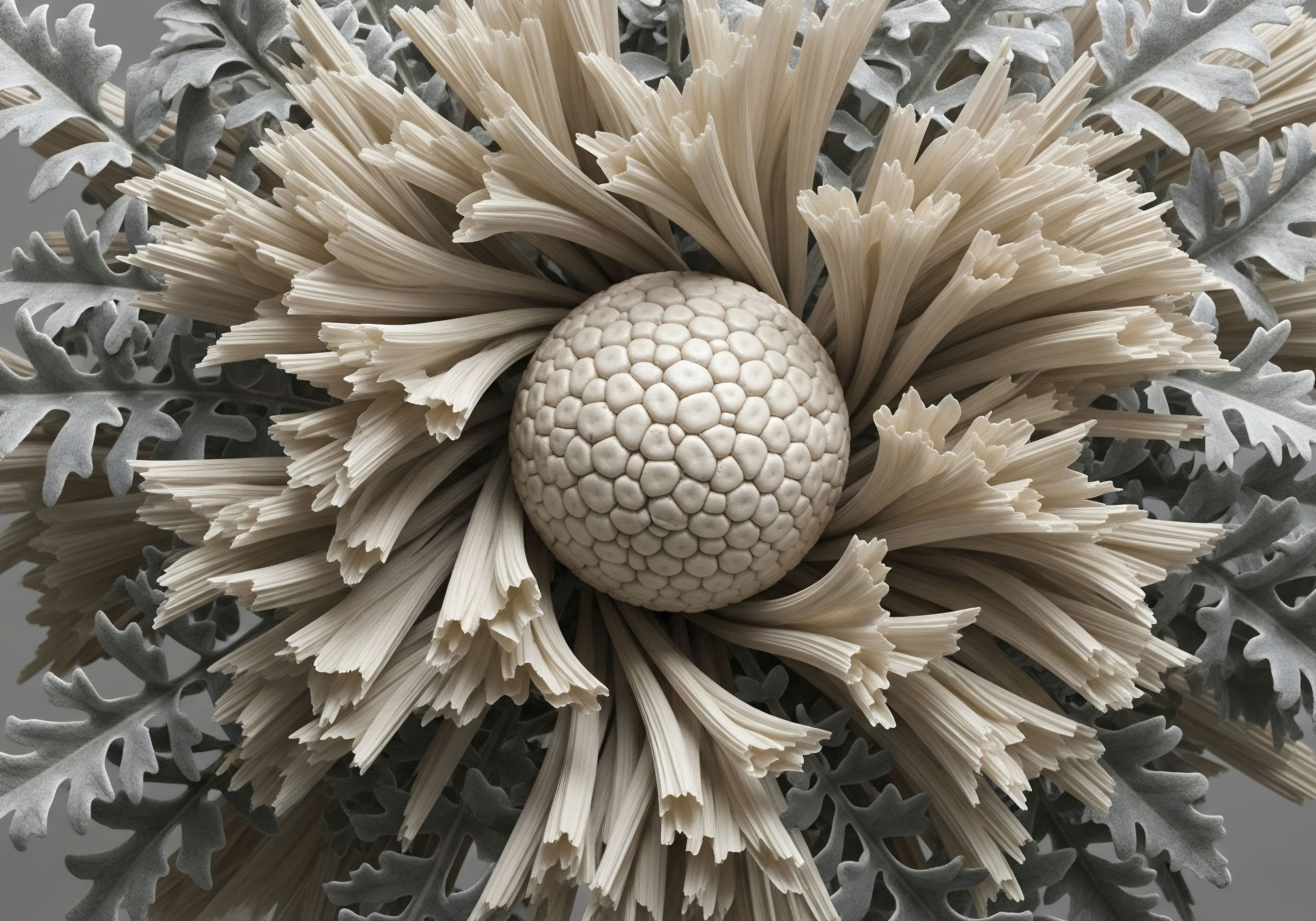

Fundamentals
Do you find yourself experiencing a persistent sense of unease, a subtle yet pervasive feeling that something within your biological system is misaligned? Perhaps your energy levels have waned, your sleep patterns are disrupted, or your mental clarity feels diminished.
These sensations often prompt a deeply personal inquiry ∞ how do I reconcile my aspirations for an optimized self with the biological realities of my natural self? This inquiry is not a simple philosophical exercise; it stems from tangible physiological shifts that affect daily existence. It reflects a desire to regain the vitality that once felt inherent, to function at a higher capacity without compromising the body’s intrinsic design.
Many individuals encounter a point where their internal biological rhythms appear to deviate from their desired state of well-being. This divergence frequently manifests as symptoms that, while common, can be profoundly disruptive. A feeling of being “off” can arise from subtle imbalances within the endocrine system, the body’s intricate network of glands and hormones.
Hormones serve as chemical messengers, orchestrating countless bodily processes, from metabolism and mood to sleep and reproductive function. When these messengers are out of sync, the repercussions can be felt across multiple physiological domains.

Understanding Endocrine System Basics
The endocrine system operates through a series of interconnected glands that produce and release hormones directly into the bloodstream. These hormones then travel to target cells and organs, initiating specific responses. Consider the adrenal glands, which produce cortisol, a hormone vital for stress response and metabolism. Or think of the thyroid gland, which generates thyroid hormones regulating metabolic rate and energy production. Each component plays a specific role, yet all are part of a larger, coordinated system.
A central concept in endocrinology is the idea of a feedback loop. This mechanism ensures that hormone levels remain within a healthy range. For instance, when a particular hormone concentration rises, the body often signals the producing gland to reduce its output, maintaining equilibrium. Conversely, if levels drop, the system prompts increased production. This regulatory process is akin to a sophisticated thermostat, constantly adjusting to maintain a stable internal environment.
The body’s internal messaging system, comprised of hormones, orchestrates a vast array of physiological processes.
Disruptions to these delicate feedback loops can lead to a cascade of effects. For example, a decline in gonadal hormone production, such as testosterone in men or estrogen and progesterone in women, can trigger a range of symptoms. These symptoms might include reduced physical stamina, changes in body composition, altered sleep architecture, and shifts in cognitive function. Recognizing these symptoms as potential indicators of hormonal shifts marks the initial step toward understanding one’s biological landscape.

Hormonal Shifts and Daily Life
Life transitions, including aging, periods of heightened stress, or significant lifestyle changes, frequently correlate with shifts in hormonal balance. For men, a gradual decline in testosterone, often termed andropause, can begin in middle age, leading to symptoms like decreased libido, fatigue, and a reduction in muscle mass.
Women experience more pronounced hormonal fluctuations during perimenopause and menopause, characterized by irregular menstrual cycles, hot flashes, mood variations, and sleep disturbances. These are not merely inconveniences; they represent real physiological changes that impact quality of life.
Addressing these changes involves a careful examination of individual biological markers and a personalized approach to restoring balance. The goal is not to override the body’s natural processes but to support and recalibrate them, allowing for a return to optimal function. This involves working with the body’s inherent intelligence, providing it with the precise signals and building blocks it requires to operate efficiently.


Intermediate
Moving beyond the foundational understanding of hormonal systems, we can examine specific clinical protocols designed to address identified imbalances. These interventions aim to support the body’s endocrine function, helping individuals regain a sense of vitality and well-being. The application of these protocols is highly individualized, based on comprehensive diagnostic assessments and a thorough understanding of a person’s unique physiological profile.

Targeted Hormone Support Applications
Hormone support protocols are tailored to distinct patient groups, addressing their specific needs and symptoms. These applications typically involve the careful administration of bioidentical hormones or peptide compounds, working to restore physiological levels and functions. The objective is to bring the body’s internal communication back into alignment, allowing cells and organs to perform their roles effectively.

Testosterone Support for Men
For men experiencing symptoms associated with low testosterone, often referred to as hypogonadism or andropause, targeted testosterone support can be a significant intervention. The standard protocol frequently involves weekly intramuscular injections of Testosterone Cypionate, typically at a concentration of 200mg/ml. This method provides a steady supply of the hormone, helping to alleviate symptoms such as reduced energy, decreased muscle mass, and diminished libido.
To maintain the body’s natural testosterone production and preserve fertility, a gonadotropin-releasing hormone (GnRH) agonist like Gonadorelin is often included. This peptide is administered via subcutaneous injections, usually twice weekly, stimulating the pituitary gland to release luteinizing hormone (LH) and follicle-stimulating hormone (FSH). These hormones, in turn, signal the testes to produce testosterone and sperm.
Carefully administered testosterone support can restore physiological balance for men experiencing low hormone levels.
Estrogen conversion from testosterone can occur, potentially leading to undesirable side effects. To mitigate this, an aromatase inhibitor such as Anastrozole is often prescribed as an oral tablet, typically twice weekly. This medication helps to block the conversion of testosterone into estrogen, maintaining a more favorable hormonal ratio. In some cases, Enclomiphene may be added to further support LH and FSH levels, particularly when fertility preservation is a primary concern.

Hormone Balance for Women
Women, especially those in pre-menopausal, peri-menopausal, or post-menopausal stages, can experience a range of symptoms related to hormonal fluctuations, including irregular cycles, mood changes, hot flashes, and reduced libido. Protocols for women often involve a combination of hormonal agents.
Testosterone Cypionate is administered in much lower doses for women, typically 10 ∞ 20 units (0.1 ∞ 0.2ml) weekly via subcutaneous injection. This small dose can significantly improve energy, mood, and sexual function without masculinizing side effects. Progesterone is also a key component, prescribed based on menopausal status to support uterine health and alleviate symptoms like sleep disturbances and anxiety.
Another option for long-acting testosterone delivery is pellet therapy, where small pellets are inserted subcutaneously, releasing a consistent dose over several months. Anastrozole may be included with pellet therapy when appropriate, particularly if there is a concern about excessive estrogen conversion.
- Testosterone Cypionate ∞ Weekly subcutaneous injections (0.1 ∞ 0.2ml) for energy and libido.
- Progesterone ∞ Oral or topical administration, tailored to menopausal status, supporting mood and sleep.
- Pellet Therapy ∞ Long-acting subcutaneous testosterone delivery, often with Anastrozole if indicated.

Post-Therapy and Fertility Protocols
For men who have discontinued testosterone support or are actively trying to conceive, specific protocols are implemented to restore natural testicular function and promote fertility. This involves stimulating the body’s intrinsic hormone production pathways.
The protocol commonly includes Gonadorelin to stimulate LH and FSH release, alongside selective estrogen receptor modulators (SERMs) such as Tamoxifen and Clomid. These SERMs work by blocking estrogen’s negative feedback on the pituitary, thereby increasing the release of gonadotropins and stimulating endogenous testosterone production. Anastrozole may be optionally included to manage estrogen levels during this period.

Growth Hormone Peptide Support
Peptide therapies offer another avenue for physiological support, particularly for active adults and athletes seeking benefits such as improved body composition, enhanced recovery, and better sleep. These peptides stimulate the body’s own production of growth hormone (GH), avoiding direct GH administration.
Key peptides in this category include Sermorelin, a growth hormone-releasing hormone (GHRH) analog that stimulates the pituitary to release GH. Ipamorelin and CJC-1295 are often combined; Ipamorelin is a GH secretagogue, while CJC-1295 is a GHRH analog, providing a synergistic effect for sustained GH release.
Tesamorelin is another GHRH analog, specifically recognized for its role in reducing visceral fat. Hexarelin is a potent GH secretagogue, and MK-677 (Ibutamoren) is an orally active GH secretagogue that increases GH and IGF-1 levels.
| Peptide Name | Primary Mechanism | Reported Benefits |
|---|---|---|
| Sermorelin | Stimulates pituitary GH release | Improved sleep, recovery, body composition |
| Ipamorelin / CJC-1295 | Synergistic GH secretagogue / GHRH analog | Enhanced muscle gain, fat loss, anti-aging effects |
| Tesamorelin | GHRH analog | Visceral fat reduction, cognitive support |
| Hexarelin | Potent GH secretagogue | Muscle growth, increased strength |
| MK-677 (Ibutamoren) | Oral GH secretagogue | Increased GH/IGF-1, appetite stimulation |

Other Targeted Peptides
Beyond growth hormone support, other peptides address specific physiological needs. PT-141 (Bremelanotide) is a melanocortin receptor agonist used for sexual health, specifically to address sexual dysfunction in both men and women by acting on central nervous system pathways. Pentadeca Arginate (PDA) is a peptide recognized for its potential in tissue repair, wound healing, and modulation of inflammatory responses, supporting recovery and cellular integrity.
Peptide therapies offer precise biological signaling to support various physiological functions, from growth hormone release to tissue repair.
These protocols represent a clinically informed approach to supporting the body’s inherent capacity for balance and function. They are not about creating an artificial state, but rather about providing the necessary biochemical signals to allow the body to operate as it was designed, mitigating the effects of age-related decline or specific deficiencies.


Academic
A deeper examination of hormonal health necessitates a systems-biology perspective, recognizing that the endocrine system does not operate in isolation. Its intricate connections with metabolic pathways, neurological function, and inflammatory processes underscore the complexity of achieving and maintaining physiological equilibrium. The reconciliation of an “optimized self” with a “natural self” becomes a sophisticated act of biological recalibration, grounded in understanding these interdependencies.

The Hypothalamic-Pituitary-Gonadal Axis
At the core of reproductive and sexual hormone regulation lies the Hypothalamic-Pituitary-Gonadal (HPG) axis. This neuroendocrine pathway exemplifies a classic feedback loop. The hypothalamus, a region of the brain, releases gonadotropin-releasing hormone (GnRH). GnRH then stimulates the anterior pituitary gland to secrete two key gonadotropins ∞ luteinizing hormone (LH) and follicle-stimulating hormone (FSH).
In men, LH acts on the Leydig cells in the testes to stimulate testosterone production, while FSH promotes spermatogenesis in the Sertoli cells. In women, LH triggers ovulation and corpus luteum formation, leading to progesterone production, while FSH stimulates follicular development and estrogen synthesis in the ovaries.
The gonadal hormones (testosterone, estrogen, progesterone) then exert negative feedback on the hypothalamus and pituitary, regulating their own production. Disruptions at any point along this axis can lead to hormonal deficiencies or excesses, manifesting as a range of clinical symptoms.

Metabolic Interplay with Hormonal Status
The relationship between hormonal status and metabolic function is bidirectional and highly significant. For instance, low testosterone in men is frequently associated with metabolic syndrome, characterized by central obesity, insulin resistance, dyslipidemia, and hypertension. Adipose tissue, particularly visceral fat, contains the enzyme aromatase, which converts testosterone into estrogen. Elevated estrogen levels in men can further suppress LH and FSH, exacerbating testosterone deficiency and creating a vicious cycle.
Similarly, in women, hormonal shifts during perimenopause can influence glucose metabolism and fat distribution. Declining estrogen levels are linked to increased abdominal adiposity and a higher risk of insulin resistance. The adipokines, hormones secreted by fat cells, such as leptin and adiponectin, also play a role in regulating appetite, energy expenditure, and insulin sensitivity, creating a complex interplay with sex hormones.
| Hormone | Metabolic Impact | Clinical Relevance |
|---|---|---|
| Testosterone (Men) | Insulin sensitivity, muscle mass, fat distribution | Low levels linked to metabolic syndrome, increased visceral fat |
| Estrogen (Women) | Glucose homeostasis, lipid metabolism, fat storage | Declining levels associated with insulin resistance, central adiposity |
| Growth Hormone | Protein synthesis, lipolysis, glucose counter-regulation | Deficiency can lead to increased fat mass, reduced muscle |
| Cortisol | Glucose production, protein breakdown, fat storage | Chronic elevation linked to insulin resistance, abdominal obesity |

Neurotransmitter Function and Hormonal Balance
The brain’s neurotransmitter systems are profoundly influenced by hormonal fluctuations, affecting mood, cognition, and overall well-being. Serotonin, dopamine, and gamma-aminobutyric acid (GABA) are key neurotransmitters whose synthesis and receptor sensitivity can be modulated by sex steroids and thyroid hormones. For example, estrogen influences serotonin synthesis and receptor density, which partly explains mood variations experienced by women during menstrual cycles, perimenopause, and menopause.
Testosterone also plays a role in dopaminergic pathways, impacting motivation, reward, and executive function. Men with low testosterone often report reduced drive and a diminished sense of well-being, which can be linked to altered dopamine signaling. Thyroid hormones are essential for proper brain development and function throughout life, influencing neurotransmitter synthesis, neuronal excitability, and synaptic plasticity. Hypothyroidism can lead to symptoms such as cognitive slowing, depression, and fatigue.
The intricate dance between hormones and neurotransmitters profoundly shapes our emotional state and cognitive abilities.
The administration of exogenous hormones or peptides, as discussed in intermediate protocols, is not merely about replacing a missing substance. It is about sending precise biochemical signals that can ripple through these interconnected systems, influencing gene expression, enzyme activity, and cellular communication.
For instance, the use of Sermorelin or Ipamorelin/CJC-1295 to stimulate endogenous growth hormone release aims to restore a more youthful physiological signaling environment, which can positively impact not only body composition but also sleep architecture and cognitive processing.
Understanding these deep biological mechanisms allows for a more sophisticated approach to personal well-being. It moves beyond symptomatic relief to address the underlying physiological dysregulation, supporting the body’s inherent capacity for health and resilience. The objective is to facilitate a return to a state where the body’s natural systems operate with optimal efficiency, aligning the internal biological reality with the individual’s desire for peak function.

References
- Bhasin, S. et al. “Testosterone Therapy in Men With Hypogonadism ∞ An Endocrine Society Clinical Practice Guideline.” Journal of Clinical Endocrinology & Metabolism, vol. 103, no. 5, 2018, pp. 1715 ∞ 1744.
- Nieschlag, E. & Behre, H. M. (Eds.). Testosterone ∞ Action, Deficiency, Substitution. Cambridge University Press, 2012.
- Shabsigh, R. et al. “Clomiphene Citrate and Testosterone Replacement Therapy in Men with Hypogonadism ∞ A Review.” Current Opinion in Urology, vol. 27, no. 6, 2017, pp. 543 ∞ 548.
- Davis, S. R. et al. “Global Consensus Position Statement on the Use of Testosterone Therapy for Women.” Journal of Clinical Endocrinology & Metabolism, vol. 104, no. 10, 2019, pp. 4660 ∞ 4666.
- Kavoussi, P. K. & Costabile, R. A. “Oral Gonadotropin-Releasing Hormone Agonists and Antagonists for Male Infertility.” Translational Andrology and Urology, vol. 5, no. 4, 2016, pp. 579 ∞ 585.
- Sigalos, J. T. & Pastuszak, A. W. “The Safety and Efficacy of Growth Hormone-Releasing Peptides in the Adult Patient.” Sexual Medicine Reviews, vol. 6, no. 1, 2018, pp. 86 ∞ 95.
- Pfaus, J. G. et al. “Bremelanotide ∞ An Overview of its Clinical Development for Female Sexual Dysfunction.” Journal of Sexual Medicine, vol. 16, no. 10, 2019, pp. 1531 ∞ 1540.
- Guyton, A. C. & Hall, J. E. Textbook of Medical Physiology. 13th ed. Elsevier, 2016.
- Kelly, D. M. & Jones, T. H. “Testosterone and Obesity.” Obesity Reviews, vol. 16, no. 7, 2015, pp. 581 ∞ 606.
- Fink, G. et al. “Estrogen and Serotonin ∞ A Review of the Interplay Between These Two Systems.” Psychoneuroendocrinology, vol. 29, no. 10, 2004, pp. 1215 ∞ 1234.

Reflection
Considering your biological systems is a deeply personal endeavor, one that extends beyond simply addressing symptoms. It involves a commitment to understanding the intricate mechanisms that govern your vitality. The knowledge presented here serves as a starting point, a framework for recognizing the signals your body communicates. Your individual path toward reclaiming optimal function will be unique, requiring careful observation and a willingness to engage with precise, evidence-based strategies.
The journey toward aligning your desired state of well-being with your biological reality is an ongoing process. It calls for a partnership with clinical expertise, translating complex data into actionable steps. This collaborative approach allows for continuous adjustment and refinement, ensuring that interventions are always tailored to your evolving needs. Ultimately, this understanding empowers you to make informed choices, guiding you toward a sustained state of robust health and energetic living.



